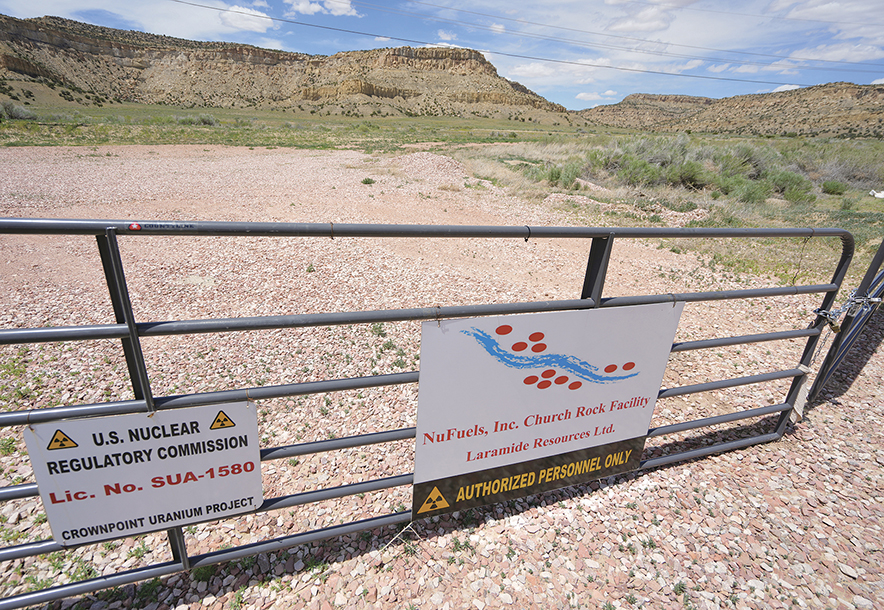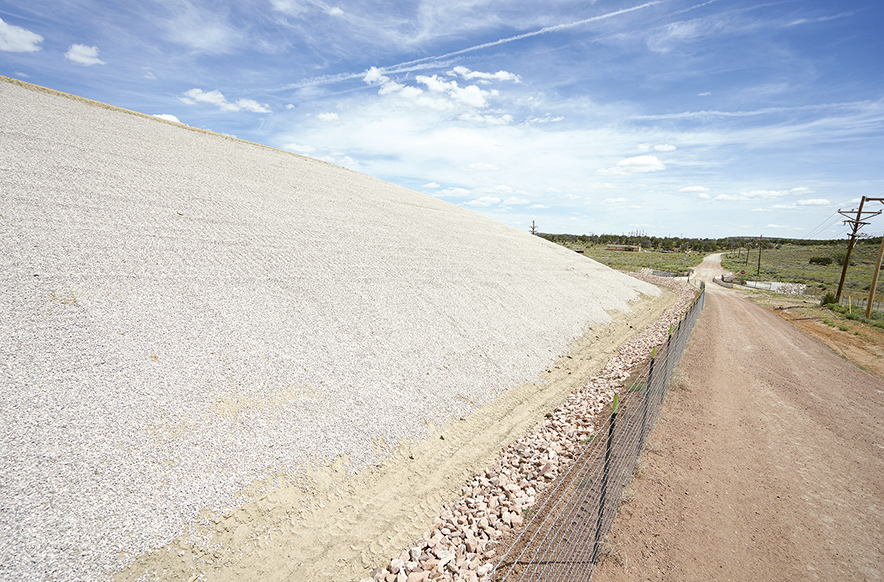
Many hope, pray that Congress passes RECA

Special to the Times | Donovan Quintero
A gate is locked at the NuFuels Inc. Church Rock Facility, along the west side of State Highway 566, in Church Rock, N.M.
By Donovan Quintero
Special to the Times
WINDOW ROCK — Jennifer Nez hopes Sen. Josh Hawley’s expansive Radiation Exposure Compensation Act passes.
If it does, she said it’ll benefit her family. However, it faces staunch Republican House Leader Mike Johnson’s decision not to vote despite a looming June 10 expiration date.
Speaker Johnson (R-LA) canceled a vote on legislation to extend RECA following backlash from supporters of a more expansive bill sponsored by Sen. Hawley (R-Mo.), which passed the Senate in April. The bill would extend RECA for six years and expand its coverage to multiple states.

Special to the Times | Donovan Quintero
Jennifer Nez sends invitations to state and tribal leaders for the upcoming Red Water Pond Road Community Association event on July 13.
Nez moved back from Phoenix not long ago to care for her mother, Bertha Nez, 79, and is part of the Red Water Pond Road Community Association. The association has been advocating for the cleanup of Quivira Mine, formerly known as Kerr-McGee Mine. She said her mother and aunts have been trying to get the companies and federal government to clean up the tailings they left in a huge pile next to their homes near Church Rock, New Mexico.
They have been living near where the largest uranium spill happened back in 1979, she said. “I was born in 1976. I was three years old, living in Fort Defiance, at the time of the spill,” Jennifer Nez said on Tuesday.
Nez was preparing for the Red Water Pond Road Association’s upcoming July 13 event highlighting the 1979 spill with a walk, followed by a discussion from guest speakers, and sending out invitations to elected state, federal, and tribal leaders, as well as the general public.
Mill tailings, living with repercussions
A Church Rock Mill Tailings Spill 1983 summary report issued by the New Mexico Environmental Improvement Division found approximately 94 million gallons of mill waste fluids and 1,100 tons of tailings liquid were released at the United Nuclear Corporation uranium mill after the south tailings pond failed.
The report concluded that the spill contained several radioactive materials and chemicals that posed potential threats to public health and the environment. Of particular concern, the report summarized radionuclides present in uranium ore as primarily uranium-238, thorium-230, radium-226, lead-210, and polonium-210, toxic metals including elemental lead, molybdenum, arsenic, and selenium.
Jennifer Nez said she was too young to remember the spill but has lived with the repercussions ever since.
“Everybody that has been impacted on this side of the mine has had health issues, from respiratory to heart issues,” she said. “Our families have been displaced twice in the past, and we were moved for cleanup, soil clean up to where they had to leave, and the homes boarded up. They had to have them in motels for months at a time. The second time they did it again, they found apartments in Gallup. So, they were displaced for that time. So, the third time, they had to be removed, so the waste was cleaned up.”
Whether the RECA amendments pass or not, Nez said her family will never stop experiencing the hardship the spill created for them. She said that if the amendments do pass, compensation could help them pay for medical bills and other financial difficulties that the spill has caused them over the years.
“With RECA, we support it because a lot of my family members worked in those mines — Kerr-McGee because it’s right there. My mom just lost one of her younger sisters last year, and she actually worked at the mine, and she passed away from respiratory and heart issues associated to, from what we gather, from working in the mine for so long,” Nez shared. “We have uncles, everybody that’s going through the same health conditions later in life. Those that did work in the mine are affected. They have health issues.”
Nez said if the amendments pass, her family could start benefiting from it.
Her uncle, Larry King, agrees.
“Well, I have known a lot of former coworkers, former workers from this area. A lot of them have passed on without receiving any benefits. And the ones that are still around — I’m one of them — I’m a post seventy-one, and to deny us, what I believe, that we should be compensated,” King said on Tuesday in Church Rock.
He went on to explain that he started mining for uranium right out of high school and that the mining companies did not tell him or others of the dangers associated with mining for uranium.
“I was only eighteen years old when I started working for uranium. We were never informed about the consequences of being exposed to radiation, especially at a very young age,” King said.
Uranium miners study
In 1950, the U.S. Public Health Service began studying uranium miners. Despite having no authority to enter privately operated mines in the Navajo Nation, they conducted physical examinations of miners and environmental studies relating to silica dust and radiation levels, according to a research report by Doug Brugge and Rob Goble titled “The History of Uranium Mining and the Navajo People.”
Their research revealed that it was known since the 1930s that uranium miners often lost their lives when they got cancers or respiratory issues associated with mining for uranium without properly exercising safety measures.

Special to the Times | Donovan Quintero
Tailings are covered with gravel on Tuesday on Red Water Pond Road in Pinedale, N.M.
Leslie Begay from Coyote Canyon, New Mexico, who was in Washington, D.C., in April, has made frequent trips to the Nation’s Capital advocating for the extension and improvement of RECA programs so that he can benefit from them as well.
The existing laws limit claims for uranium mine workers to those who were employed before 1971, despite uranium mines continuing to operate on the Navajo Nation throughout the 1980s. Navajo uranium miners continued to provide the U.S. with fuel for atomic energy production.
Begay went to work as a uranium miner after serving in the Vietnam War. According to current RECA laws, Begay does not qualify for compensation benefits.
The current form of RECA excludes core drillers from eligible employment categories, even though core drillers were exposed to dust and radiation, eventually suffering severe disease and death.
Begay explained to Montana Congressman Ryan Zinke in July of last year how he had both of his lungs replaced during a lung transplant.
“I was an underground miner. I did all kinds of stuff,” Begay, a Navajo Uranium Radiation Victims Committee member, told Congressman Zinke at his office in Washington, D.C. “By the time you get out of the mine, you’d be full of mud and be covered everywhere. It was not safe no matter what you wore.”
According to the Navajo Nation Washington Office, 30 million tons of uranium were extracted from the Navajo Nation. Over 60 million tons were extracted in the U.S., Half of which was from the Navajo Nation.
Begay told Zinke that he was only given a hard hat, safety glasses, and a rain jacket when he worked in the uranium mine.
To proceed with its epidemiological study, the Public Health Service decided that individual miners would not be told of possible potential hazards from radiation in the mines for fear that many would quit and others would be difficult to secure because of fear of cancer. At the time, it was feared that it would interrupt the production of uranium, Brugge’s and Goble’s research read.
“I wish they would have warned us that this thing was bad,” Begay said.
Uranium boom, advocating bill’s passing
The Navajo Nation Council members, along with Navajo Nation President Buu Nygren, were in Washington, D.C., recently advocating for the bill’s passing. Its passage would expand eligibility for compensation to Jennifer Nez’s family members, who worked in the uranium mines, and Begay, who was employed after 1971.
At the height of the uranium boom, four mining and milling operations were operating near Shiprock, the Carrizo Mountains, Cove, Arizona, Monument Valley, Utah, and Church Rock and Kayenta.
At the time, Navajo miners who agreed to be part of the PHS study and had significant abnormalities were informed of the findings and advised to seek medical care at one of the Indian Health Service hospitals. According to Brugge and Goble, PHS reported its abnormal findings to the Indian hospital at Fort Defiance.
“Since the 1950s, 1960s, and 1970s, what was known as Kerr-McGee Mine, the northeast side where reside, we’ve been dealing with as a community organization, is trying to get the Quivira Mine cleaned up, trying to get the tailings from that mine out of where we call home,” Nez said.
“It’s affected four generations in our lifetime. I have a granddaughter, my mom’s great-granddaughter, who is affected. We have livestock that has been affected, vegetation has been affected, we can’t plant anything because it would be contaminated,” Nez said. “It’s just unfortunate for us. We can’t even have a homesite lease or build anything because the Navajo Nation has refused to issue or renew homesite leases because of that. If you don’t have one there or you haven’t already established one, they’re not going to issue one because of how contaminated it is there.”
In a statement, Speaker Crystalyne Curley expressed her gratitude to U.S. Sens. Josh Hawley of Missouri, Ben Ray Luján of New Mexico, Mike Crapo of Idaho, and Representatives Teresa Leger Fernandez of New Mexico, Paul Gosar and Eli Crane of Arizona. Curley said their collective support is crucial in addressing these historic wrongs.
“As the legislative deadline approaches, the urgency for Congress to act intensifies. The Navajo Nation advocates for the swift passage of S. 3853 – The Radiation Exposure Compensation Reauthorization Act, to ensure that the Navajo people and other affected communities no longer face delays in receiving the justice they deserve,” the statement read.
The Red Water Pond Road Community Association event will occur in Pine Dale, New Mexico. It begins at 6 a.m. with a prayer, followed by a walk near the 1979 uranium tailings spill. Guest speakers will hold discussions at the residence, and the event will conclude at 2 p.m.
Information: Linda Jim, 505-519-8733; Jerry Whiterock, 505-979-9899.







 Highway 264,
Highway 264, I-40, WB @ Winslow
I-40, WB @ Winslow